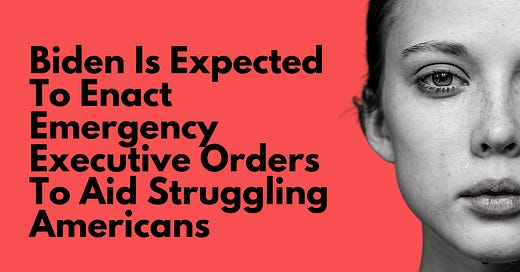Biden Is Expected To Enact Emergency Executive Orders To Aid Struggling Americans
President Joe Biden previously unveiled a two-step recovery plan to manage the Covid-19 pandemic and reinvigorate the economy. He called for a dramatic $1.9 trillion Covid-19 relief program, entitled the American Rescue Plan. This would be in addition to the previously passed $900 billion stimulus package. Biden said at the time of the announcement, "The crisis of deep human suffering is in plain sight." In a call to immediate action to turn things around, he added, "There's no time to waste. We have to act and we have to act now."
Recognizing that time is of the essence, Biden, who took office on Wednesday, plans to take executive action on Friday. His decision comes on the heels of yet another horrible weekly jobless report from the Department of Labor. Last week, 900,000 Americans filed initial unemployment claims. The previous week, 965,000 Americans sought benefits. Additionally, in the last month of 2020, employers slashed 140,000 jobs. The data shows that layoffs are stubbornly going strong. Roughly 75.6 million initial jobless claims were filed during the pandemic. This mind-numbing figure represents approximately 47% of the nation’s workforce.
Biden, in an effort to swiftly turn around the fortunes of the U.S., plans “to provide a stopgap measure of financial relief to millions of Americans.” This immediate measure is meant to get things started “while Congress begins to consider his much larger $1.9 trillion package to help those affected by the [Covid-19] pandemic.” His large proposal necessitates going through congressional approval, and Friday's executive orders can be immediately put in place without legislation required.
Biden’s economic rescue package “amounts to $400 billion for Covid-19 management, more than $1 trillion in direct relief spending and $440 billion for communities and businesses.” It is twice as high as the previous financial stimulus program.
Biden’s proposal includes the following:
Payments of $1,400 to Americans, in addition to the prior $600 payments
Increasing the federal weekly unemployment benefits to $400
An increase of the federal minimum wage to $15 per hour
Extending the eviction and foreclosure moratoriums
$350 billion in state and local government aid
$170 billion for K-12 schools and institutions of higher education
$50 billion for Covid-19 testing
$20 billion toward a national vaccine program
Increasing the Child Tax Credit to $3,000 per child ($3,600 for a child under age 6)
Biden is expected to sign two executive orders on Friday. They would call for an increase in food aid, the protection of Americans collecting unemployment and outlining a “clear path for federal workers and contractors to get a $15 hourly minimum wage.” The orders would also serve to “restore union bargaining rights revoked by the Trump administration,” with the intended goal of getting corporations to increase minimum wages as well.
Brian Deese, director of the White House National Economic Council, has called for a rapid response. It's likely that the enormity of the first $900 billion stimulus package, along with Biden’s new plan, will take time to work its way through the economy and start making an impact. The emergency action could jump-start the aid to Americans in dire need of help. There’s the potential for delays, as Congress could slow-walk the approval of Biden’s package or attempt to make substantial changes to the program.
This will be the first test for Biden to showcase his well-respected reputation for collaborating with members of the Republican Party. He has a strong, long-term relationship with former Senate Majority Leader Mitch McConnell, which may help usher through the programs. Biden needs to also work well with both the leftist-leaning faction of his party, as well as the moderate and conservative groups that could potentially oppose the scale of the stimulus programs, which would incur a frighteningly large amount of debt that future generations will be saddled with.



